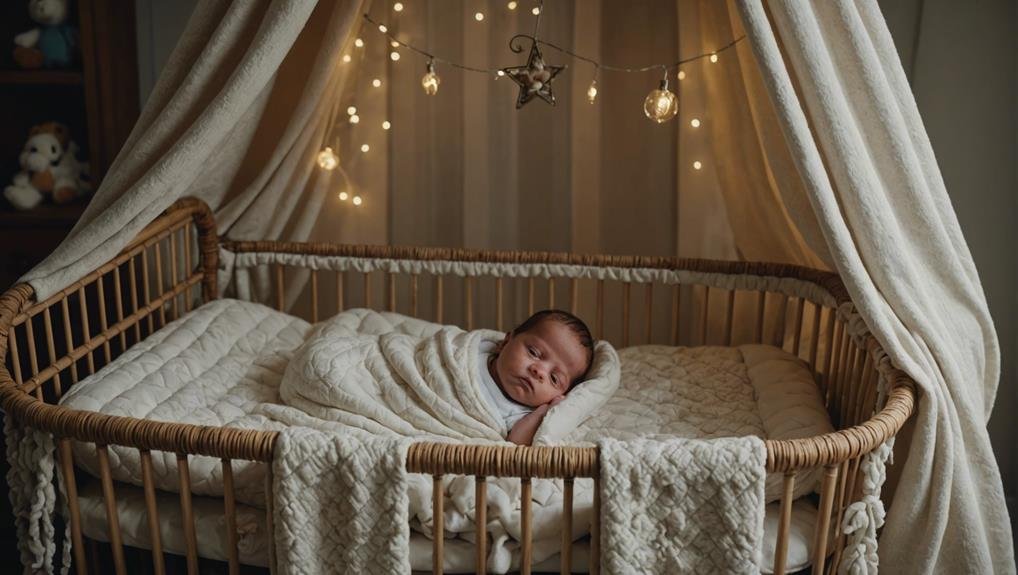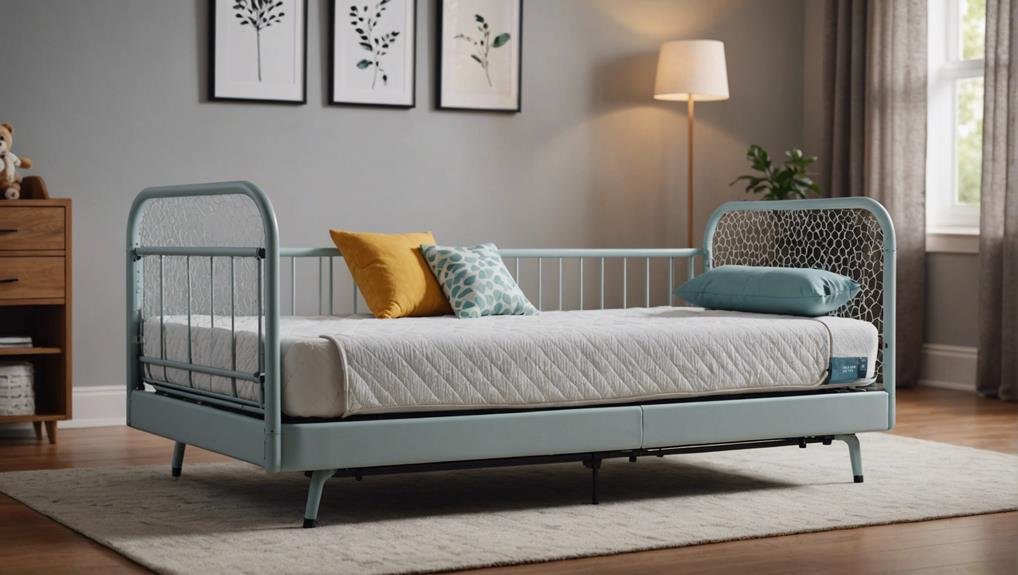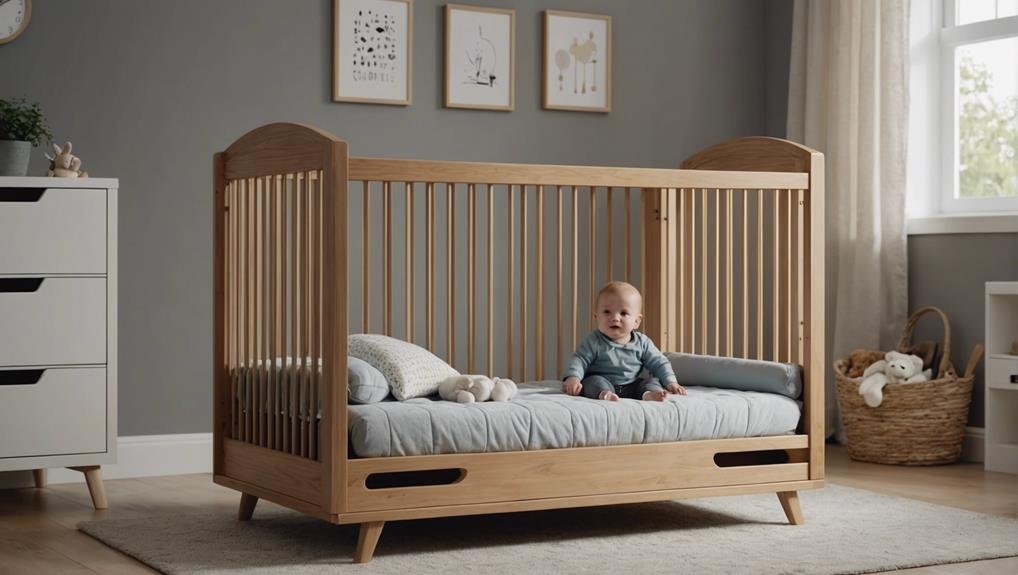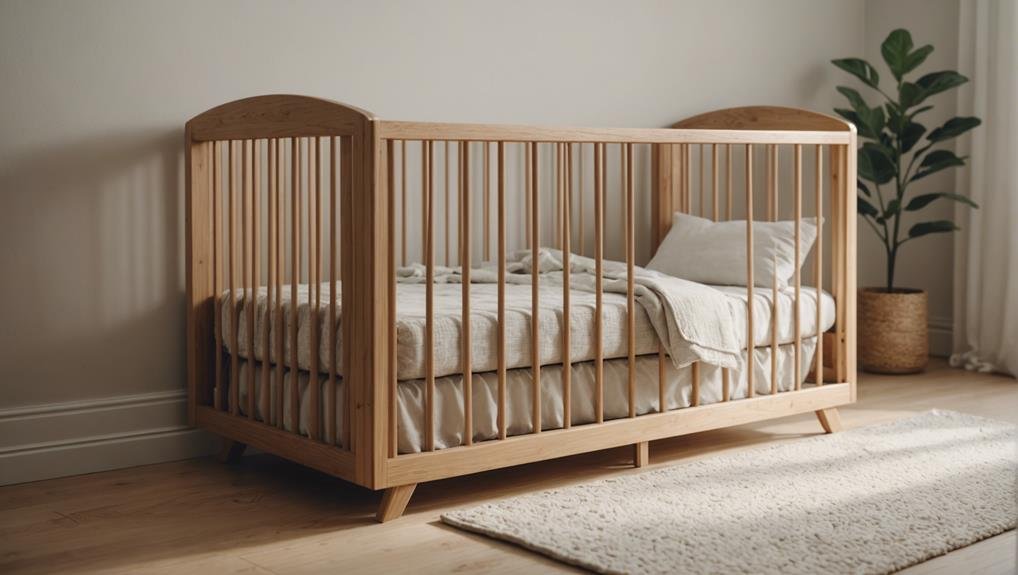"Cherishing Little Steps - A Haven for Baby and Family Journeys"
Baby Bed
When it comes to ensuring your little one's safety and comfort during sleep, the choice of a baby bed is paramount. From traditional cribs to modern bassinets, the options can be overwhelming. However, there are key factors to consider beyond just aesthetics or size. Safety standards, convenience, and adaptability are all crucial aspects to weigh in your decision-making process. So, before you make your final choice, it's essential to explore the nuances of each type of baby bed to find the perfect fit for your child.
Types of Baby Beds

When choosing a baby bed, consider the various types available to ensure you find the best fit for your little one's comfort and safety. Travel cribs are excellent for families on the go, providing a portable and secure sleeping space for your baby.
Rocking bassinets offer a gentle motion that can help soothe your little one to sleep.
For a personal touch, custom bedding allows you to create a cozy and unique environment for your baby. You can choose fabrics, colors, and patterns that match your nursery decor and style.
Canopy designs add a touch of elegance and charm to your baby's bed, creating a whimsical and dreamy space for them to rest.
Whether you opt for the convenience of a travel crib, the soothing motion of a rocking bassinet, the personalized touch of custom bedding, or the enchanting allure of canopy designs, each type of baby bed offers something special for you and your little one to enjoy.
Choosing the Right Size
Selecting the appropriate size for your baby's bed is crucial to ensure their safety and comfort as they rest and grow. When choosing a baby bed, consider the age appropriateness and growth potential of your little one. A bed that is too small might restrict movement, while one that is too large could pose safety hazards. Also, think about the mattress options available and space considerations in the nursery or your room.
Here is a helpful table to guide you in selecting the right size for your baby's bed:
| Age Appropriateness | Growth Potential | Mattress Options | Space Considerations |
|---|---|---|---|
| Newborn to 6 months | Consider future growth spurts | Choose a firm mattress for support | Measure the available space in the room |
| 6 months to 2 years | Ensure room for movement | Opt for a breathable and hypoallergenic mattress | Account for other furniture in the room |
| 2 years and older | Consider a toddler bed or twin bed | Look for waterproof mattress options | Allow space for play and growth |
Making an informed decision about the size of your baby's bed will contribute to their well-being and quality of sleep.
Safety Features to Look For

Ensure your baby's bed is equipped with essential safety features to provide a secure sleeping environment. When choosing a baby bed, prioritize mattress firmness to reduce the risk of Sudden Infant Death Syndrome (SIDS). Opt for a crib with a firm mattress that fits snugly without gaps, preventing your baby from getting trapped. Check the slat spacing on the crib; the gaps should be narrow to avoid your baby's head getting stuck. Look for non-toxic finishes to prevent harmful chemicals from affecting your little one's health.
Another crucial safety feature is adjustable mattress heights. This allows you to lower the mattress as your baby grows and becomes more mobile, preventing potential falls. Make sure the crib you choose has this feature to adapt to your baby's developmental stages.
Benefits of Bassinets
Investing in a bassinet can provide numerous benefits for both you and your baby. Bassinets are excellent tools for sleep training, as they offer a cozy and secure environment that can help establish healthy sleep patterns.
The small size of a bassinet can also give your baby a sense of security, mimicking the womb's snugness and promoting better sleep. This closeness can be particularly beneficial for attachment parenting, allowing you to easily comfort and bond with your little one throughout the night.
Furthermore, bassinets are portable, making it convenient to keep your baby close wherever you go in the house. This proximity can simplify nighttime feedings and provide peace of mind by enabling you to quickly respond to your baby's needs.
With proper use, a bassinet can support both you and your baby in creating a nurturing and secure sleep environment that fosters healthy development and strengthens your attachment bond.
Crib Vs. Co-Sleeper Comparison

When deciding between a crib and a co-sleeper for your baby, consider the specific needs and preferences of your family. Both options have their own advantages, so it's crucial to weigh them against your lifestyle.
Cribs provide a dedicated space for your baby, promoting safety and independence. They're also great for room sharing benefits if your baby starts in your room but transitions to their own space.
On the other hand, co-sleepers offer the convenience of attachment to your bed, fostering closeness while ensuring a safe sleep environment. Co-sleepers are also travel-friendly, making them ideal for families on the go.
If you value room sharing benefits and prioritize safety, a crib might be the best choice. However, if you prefer the intimacy of having your baby close at night and need a portable option, a co-sleeper could be the perfect fit.
Ultimately, the decision between a crib and a co-sleeper depends on what aligns best with your family's unique needs and lifestyle.
Eco-Friendly Materials
Opt for sustainably sourced materials when selecting a baby bed to reduce environmental impact and promote a healthier future for your little one. When choosing a crib or co-sleeper, opt for options that prioritize sustainable design and non-toxic finishes. These choices not only benefit the planet but also ensure that your baby is surrounded by a safe and healthy environment.
Consider using natural materials in the construction of the baby bed. Materials such as solid wood or bamboo are not only durable but also renewable, making them an eco-friendly choice. Pair these materials with organic bedding made from materials like organic cotton to create a cozy and chemical-free sleeping space for your baby.
Here is a helpful table to guide you in selecting eco-friendly materials for your baby bed:
| Material | Benefits | Recommendation |
|---|---|---|
| Solid Wood | Durable, Renewable | Opt for FSC certified wood |
| Bamboo | Sustainable, Eco-friendly | Look for bamboo cribs |
| Organic Cotton Bedding | Chemical-free, Gentle on skin | Choose GOTS certified bedding |
Choosing eco-friendly materials for your baby bed ensures a comfortable and safe sleeping environment while also contributing positively to the planet's well-being.
Convertible Baby Beds

Consider the versatility and longevity of convertible baby beds as you explore options for your little one's sleeping space. Convertible baby beds are a smart choice for parents looking for space-saving options without compromising on style. Modern design trends have influenced these beds, offering sleek and contemporary options that blend seamlessly with any nursery decor.
These beds come with multifunctional features that adapt as your child grows, transitioning from a crib to a toddler bed, daybed, and even a full-size bed. This flexibility ensures that your investment lasts well beyond the infant years. Customization options allow you to personalize the bed to suit your preferences, whether it's choosing the finish or adding storage compartments.
When selecting a convertible baby bed, consider factors like safety certifications, ease of conversion, and overall durability.
Best Baby Beds for Small Spaces
Explore the top baby beds designed specifically for small spaces to maximize functionality while maintaining style in your nursery. When space is limited, opting for space-saving solutions is key. Look for baby beds with minimalist designs that are sleek and compact, yet still provide all the necessary features for your little one.
Multifunctional furniture is a game-changer for small nurseries. Consider baby beds that double as changing tables or have built-in storage compartments. These stylish storage solutions not only save space but also keep all your baby essentials organized and within reach.
Choosing a baby bed that serves multiple purposes not only optimizes your space but also adds a touch of elegance to your nursery. Look for cribs with adjustable mattress heights or those that can later be converted into toddler beds. Investing in a versatile piece of furniture ensures longevity and adaptability as your child grows.
Prioritizing functionality and style in a small nursery setting can create a cozy and practical space for you and your little one.
Budget-Friendly Options

When looking for baby beds on a budget, prioritize affordability without compromising on safety and quality. Consider exploring secondhand savings or opting for DIY alternatives to save money while still providing a secure sleeping space for your little one.
Many parents find that gently used baby beds aren't only cost-effective but also come with a sense of history and charm. Additionally, getting creative with DIY projects can result in unique and personalized baby bed solutions that fit your budget.
For those with limited space, minimalist designs and space-saving solutions are excellent choices. Look for baby beds that offer functionality without sacrificing style. Convertible cribs that grow with your child or bassinets that can easily be moved around are practical options for smaller rooms.
Embracing a minimalist approach to baby furniture can help create a calming environment for both you and your baby, while also being budget-friendly.
Tips for Decorating With Baby Beds
Looking to create a cozy and stylish nursery with your baby bed as the centerpiece? Decorating with baby beds can be a delightful experience as you design a space that is both functional and visually appealing. To achieve a harmonious look, consider incorporating nursery themes, bedding options, color palettes, and wall decor that complement each other seamlessly. Here are some expert tips to help you get started:
| Nursery Themes | Bedding Options | Color Palettes |
|---|---|---|
| Woodland | Organic cotton | Soft pastels |
| Safari | Muslin blankets | Neutral tones |
| Outer space | Knit blankets | Bold primary colors |
Selecting a theme can provide a cohesive look to the nursery, while choosing bedding made from soft, safe materials ensures your baby's comfort. When it comes to color palettes, opt for calming pastels or gender-neutral tones for a soothing environment. Enhance the walls with decals, framed art, or a decorative mirror to add a personal touch to the space. By carefully curating these elements, you can create a nurturing and enchanting oasis for your little one to grow and thrive in.
Frequently Asked Questions
Can a Baby Bed Help With Sleep Training?
A baby bed can assist with sleep training by establishing positive sleep patterns and breaking sleep associations. Consistent bedtime routines and gentle sleep training methods can promote healthy sleep habits for your little one.
Are Baby Beds Easy to Assemble?
Assembling baby beds can be straightforward if you follow the assembly tips and instructions provided. Some challenges may arise, but with the right assembly tools and careful attention to the instructions, you'll have it ready in no time.
Can a Baby Bed Be Used for Travel?
When venturing with your little one, a baby bed can be your travel companion. Offering the comfort of home on the go, portable options provide safety and familiarity, ensuring peaceful nights away.
How Often Should a Baby Bed Mattress Be Replaced?
You should replace a baby bed mattress every 5-7 years for safety and comfort. Regularly check for signs of wear or damage. Opt for hypoallergenic bedding options to prevent allergies and ensure a cozy sleep environment.
Are There Any Regulations for Baby Bed Designs?
When it comes to baby bed designs, regulations ensure safety standards are met. These guidelines prioritize your little one's comfort and sleep habits. While following these rules, you can still cater to your baby's unique preferences.
Conclusion
Now that you have explored the various types of baby beds and their features, you're equipped to make an informed decision for your little one's sleep space.
Remember to prioritize safety, size, and functionality when choosing the perfect bed.
Investigate the truth of the theory that a cozy and secure sleeping environment leads to better rest for both baby and parents.
With the right baby bed, you can create a peaceful and nurturing space for your child to grow and thrive.




